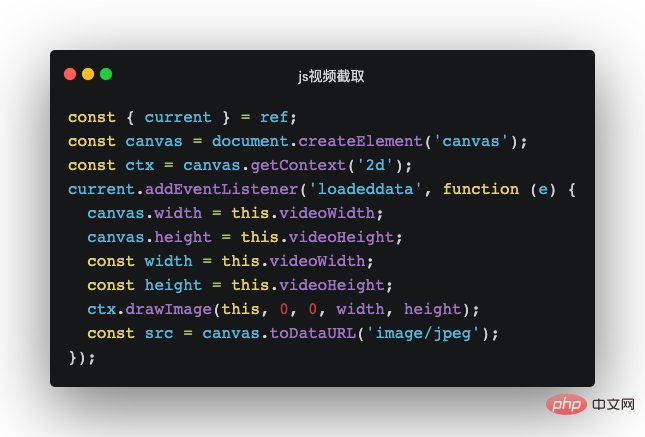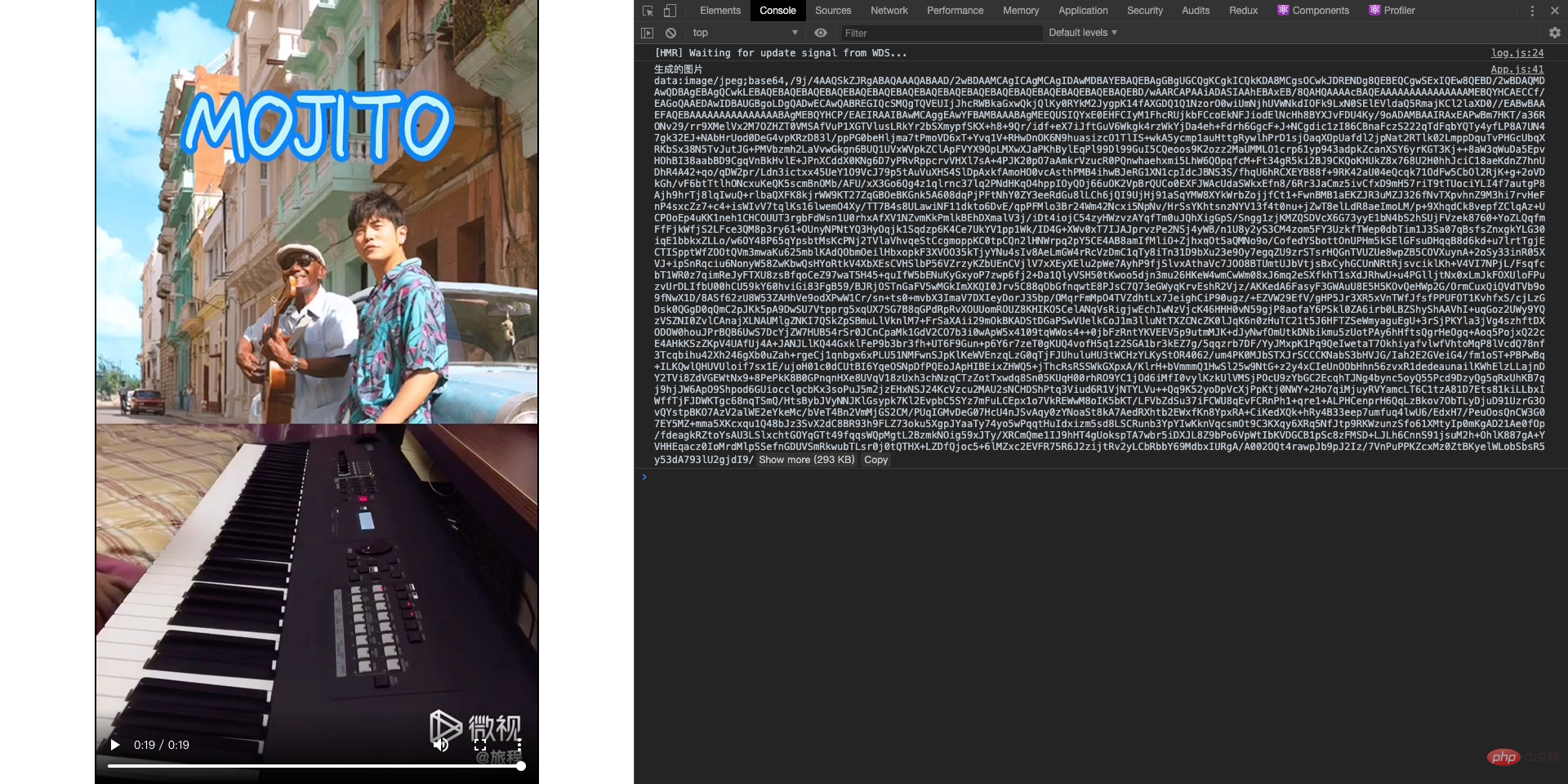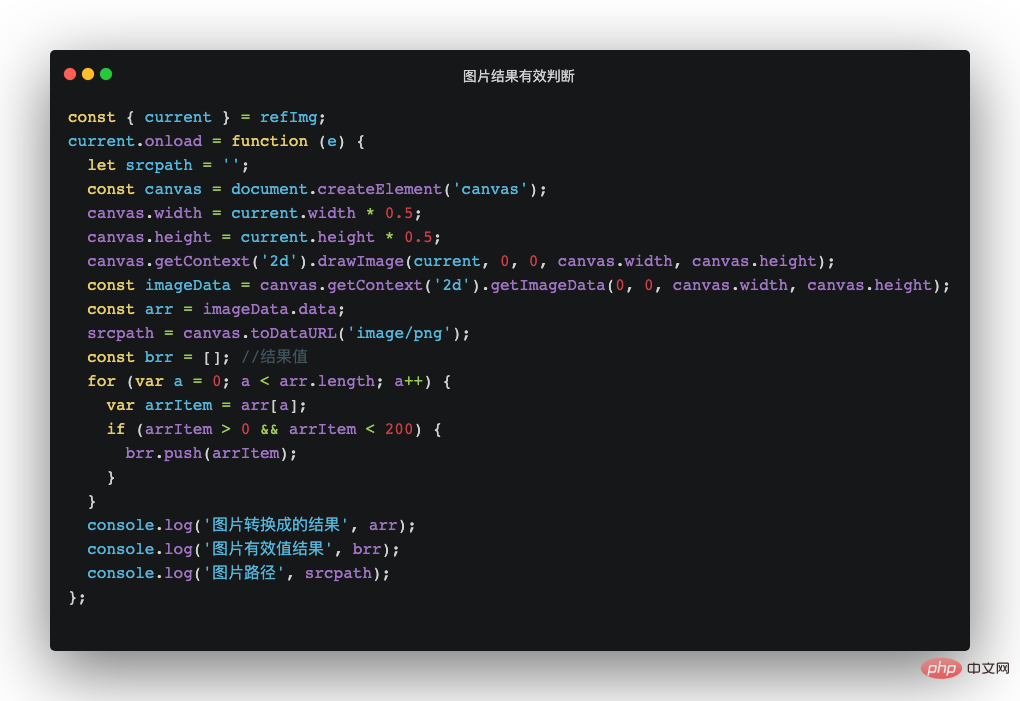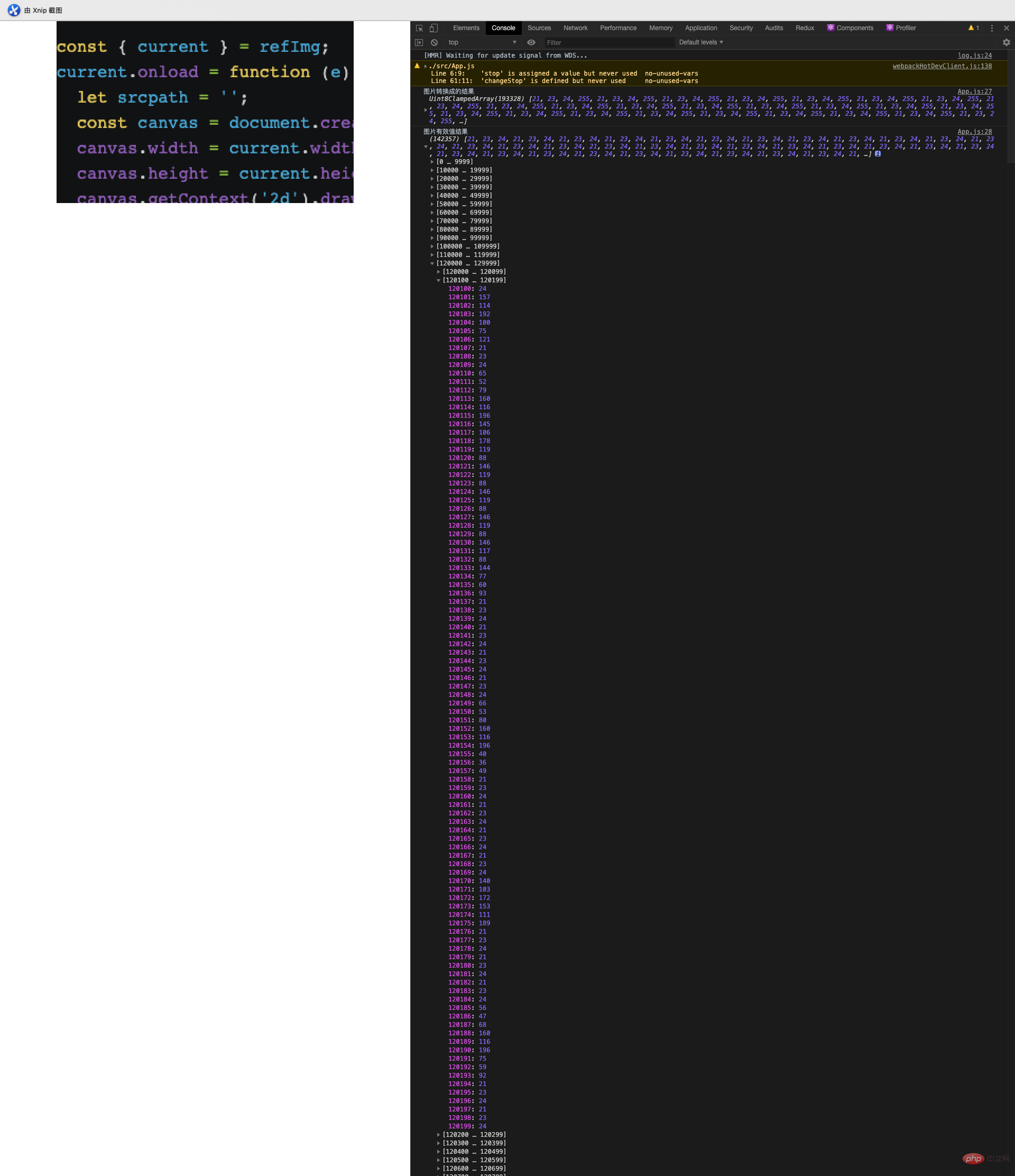Learn how to capture the first frame of a video using javascript

Related learning recommendations: javascript video tutorial
JavaScript Intercept the first frame of the video
1. Background
In the development of corporate materials, in addition to video uploading, you also need to use the first frame or perhaps several frames in the video as the video Cover display.
Problems:
Therefore, the difficulty of intercepting the first frame of the video with JS was born. However, after checking the information, I found that there are only two types of information available on the Internet. The first one iswasm ffmpeg Cooperate with the backend to intercept, the second is to intercept by JS yourself. The advantages and disadvantages are also obvious. The first one has a relatively high cost of cooperation and is not very flexible. The second one can be used under normal conditions, but there will be compatibility issues (see you later in IE) and black screen interception issues.
2. Wasm ffmpeg
The advantages and disadvantages of this method are also obvious. The cooperation cost is relatively high, and it will cause a sharp increase in web memory. However, the number of captured frames for the supported video types is Very flexible; since it involves the server, you can refer to wasm ffmpeg to capture videos.
3. JavaScript front-end interception
If you want to intercept the front-end here, you need to understand the compatibility and response events of the video and canvas tags. And it may not be so friendly to IE.
1. I won’t add too much knowledge about canvas here. Let’s mainly look at the response events of the video tag:

Execution results

According to the sequence, the first thing to be triggered turned out to be the timeupdate event. According to assumptions, the first thing to be executed should beloadedmetadata, the metadata is loaded. Regarding this, there is no clear explanation on MDN, but you can reason about it:
When currentTime is updated, the timeupdate event
# will be triggered.
##Conclusion: Although it is triggered first, the video file has not been loaded yet, and the content of the canvas itself is intercepted. Note: The timeupdate event is triggered 4-66 times per second depending on the system used. Due to the high trigger frequency, too small unit (millisecond level), event response delay and other reasons, it cannot be completely and accurately controlled.
- loadedmetadata As mentioned above, it is triggered after the metadata is loaded, but the data does not include the video file itself. Conclusion: If the video file is large and the loading time is long, the first frame that has been loaded still cannot be captured. Supplement: The URL.createObjectURL() method can basically make it invisible, but it is not safe.
- loadeddata Triggered when the current frame number (the first frame) is loaded, no problem. Conclusion: Available. Supplement: What if the first frame is a black screen and you want to use the next frame? Sorry, the number of remaining frames and the fact that they have not been loaded are not within the scope of its consideration. This event is ignored.
- canplay is triggered when the video can start playing, that is, it is triggered after the number of frames to be loaded is determined based on the number of uploaded video frames (24/25/30/60, etc.) and the playback screen is satisfied. Summary: Because there are more loading events than loadeddata (one more event), it is generally feasible. Supplement: It can be satisfied by controlling currentTime (but it cannot be as accurate as the second frame), which can be regarded as the "current playback frame".
- play It will only be triggered when playback starts, which does not meet the requirement of uploading quick screenshots.
- waiting Triggered when the next picture has been played but the next picture has not been buffered. It is suitable for inserting small advertisements.


3. Is the first frame valid?
In fact, sometimes the first frame of the captured picture is not very consistent with expectations due to poor video quality or other factors. There will always be pure black pictures, transparent pictures, white pictures and other invalid pictures. Therefore, we need to identify the validity of the image. So, how to identify the effectiveness of images?
At this time, you need to know a new attribute: Uint8ClampedArray
Uint8ClampedArray (8-bit unsigned integer fixed array ) A typed array represents an array of 8-bit unsigned integers whose values are fixed in the range 0-255; if you specify a value outside the range [0,255], it will be replaced with 0 or 255; if you specify a non-integer, then it will be set to the nearest integer. (array) contents are initialized to 0. Once created, you can reference the elements of the array using object methods, or using standard array indexing syntax (that is, using square brackets).
If you are interested in Uint8ClampedArray, you can further study Uint8ClampedArray asynchronously here.
Did you discover anything? Is 0~255 a common value? It is the hexadecimal value corresponding to the color. Okay, then, the next step is to implement what we have thought about and see if it is such a principle. 
The code is implemented, so what about the results? Here I use white pictures, transparent pictures, and black pictures to compare. Is the result obtained consistent with what we imagined: First, let’s take a look at the transparent image:

As you can see, all the results in the array are 0;
White image:

Oops, all are 255, then black should be all 0, don’t worry, let’s take a look
Black picture:

There is an unexpected number, 238, which is a color value that is biased toward 255 white. Why is this? In fact, it is because The white and transparent colors are not excessive, but the black is excessive. This problem will occur when the canvas is drawn, but it can be ignored.
After knowing the color values of these three, the next judgment will be easier. Just add a condition.

Why are it 200 and 0? In fact, you can judge the reasonable range of these two values based on the actual situation. The corresponding color value of 200 is #c8c8c8, which is gray, and 0 is transparent color, so it is judged to be an invalid image here. As long as there is no value in the brr array, it means it is an invalid picture.
So what is the actual situation? Here is another actual comparison picture:

As you can see, there are values in brr, and there are a lot of them, so this is the actual picture Valid image.
4. Finally
JavaScript has finished capturing the first frame of the video. If you still want to optimize for invalid images, just use the default image display.
4. Summary
JavaScript intercepts the first frame of the video. The process is complicated and involves a large amount of data loops, which will cause a certain amount of memory growth, but it can indeed solve this problem. , and has been used in enterprise materials. A clever optimization method is used. Only if a value in the brr array is pushed, it will break directly, which can greatly optimize performance. If you have better solutions, please share them with us!
If you want to learn more about programming, please pay attention to the php training column!
The above is the detailed content of Learn how to capture the first frame of a video using javascript. For more information, please follow other related articles on the PHP Chinese website!

Hot AI Tools

Undresser.AI Undress
AI-powered app for creating realistic nude photos

AI Clothes Remover
Online AI tool for removing clothes from photos.

Undress AI Tool
Undress images for free

Clothoff.io
AI clothes remover

Video Face Swap
Swap faces in any video effortlessly with our completely free AI face swap tool!

Hot Article

Hot Tools

Notepad++7.3.1
Easy-to-use and free code editor

SublimeText3 Chinese version
Chinese version, very easy to use

Zend Studio 13.0.1
Powerful PHP integrated development environment

Dreamweaver CS6
Visual web development tools

SublimeText3 Mac version
God-level code editing software (SublimeText3)

Hot Topics
 1664
1664
 14
14
 1423
1423
 52
52
 1318
1318
 25
25
 1268
1268
 29
29
 1248
1248
 24
24
 How to implement an online speech recognition system using WebSocket and JavaScript
Dec 17, 2023 pm 02:54 PM
How to implement an online speech recognition system using WebSocket and JavaScript
Dec 17, 2023 pm 02:54 PM
How to use WebSocket and JavaScript to implement an online speech recognition system Introduction: With the continuous development of technology, speech recognition technology has become an important part of the field of artificial intelligence. The online speech recognition system based on WebSocket and JavaScript has the characteristics of low latency, real-time and cross-platform, and has become a widely used solution. This article will introduce how to use WebSocket and JavaScript to implement an online speech recognition system.
 WebSocket and JavaScript: key technologies for implementing real-time monitoring systems
Dec 17, 2023 pm 05:30 PM
WebSocket and JavaScript: key technologies for implementing real-time monitoring systems
Dec 17, 2023 pm 05:30 PM
WebSocket and JavaScript: Key technologies for realizing real-time monitoring systems Introduction: With the rapid development of Internet technology, real-time monitoring systems have been widely used in various fields. One of the key technologies to achieve real-time monitoring is the combination of WebSocket and JavaScript. This article will introduce the application of WebSocket and JavaScript in real-time monitoring systems, give code examples, and explain their implementation principles in detail. 1. WebSocket technology
 How to use JavaScript and WebSocket to implement a real-time online ordering system
Dec 17, 2023 pm 12:09 PM
How to use JavaScript and WebSocket to implement a real-time online ordering system
Dec 17, 2023 pm 12:09 PM
Introduction to how to use JavaScript and WebSocket to implement a real-time online ordering system: With the popularity of the Internet and the advancement of technology, more and more restaurants have begun to provide online ordering services. In order to implement a real-time online ordering system, we can use JavaScript and WebSocket technology. WebSocket is a full-duplex communication protocol based on the TCP protocol, which can realize real-time two-way communication between the client and the server. In the real-time online ordering system, when the user selects dishes and places an order
 How to implement an online reservation system using WebSocket and JavaScript
Dec 17, 2023 am 09:39 AM
How to implement an online reservation system using WebSocket and JavaScript
Dec 17, 2023 am 09:39 AM
How to use WebSocket and JavaScript to implement an online reservation system. In today's digital era, more and more businesses and services need to provide online reservation functions. It is crucial to implement an efficient and real-time online reservation system. This article will introduce how to use WebSocket and JavaScript to implement an online reservation system, and provide specific code examples. 1. What is WebSocket? WebSocket is a full-duplex method on a single TCP connection.
 JavaScript and WebSocket: Building an efficient real-time weather forecasting system
Dec 17, 2023 pm 05:13 PM
JavaScript and WebSocket: Building an efficient real-time weather forecasting system
Dec 17, 2023 pm 05:13 PM
JavaScript and WebSocket: Building an efficient real-time weather forecast system Introduction: Today, the accuracy of weather forecasts is of great significance to daily life and decision-making. As technology develops, we can provide more accurate and reliable weather forecasts by obtaining weather data in real time. In this article, we will learn how to use JavaScript and WebSocket technology to build an efficient real-time weather forecast system. This article will demonstrate the implementation process through specific code examples. We
 Simple JavaScript Tutorial: How to Get HTTP Status Code
Jan 05, 2024 pm 06:08 PM
Simple JavaScript Tutorial: How to Get HTTP Status Code
Jan 05, 2024 pm 06:08 PM
JavaScript tutorial: How to get HTTP status code, specific code examples are required. Preface: In web development, data interaction with the server is often involved. When communicating with the server, we often need to obtain the returned HTTP status code to determine whether the operation is successful, and perform corresponding processing based on different status codes. This article will teach you how to use JavaScript to obtain HTTP status codes and provide some practical code examples. Using XMLHttpRequest
 How to use insertBefore in javascript
Nov 24, 2023 am 11:56 AM
How to use insertBefore in javascript
Nov 24, 2023 am 11:56 AM
Usage: In JavaScript, the insertBefore() method is used to insert a new node in the DOM tree. This method requires two parameters: the new node to be inserted and the reference node (that is, the node where the new node will be inserted).
 JavaScript and WebSocket: Building an efficient real-time image processing system
Dec 17, 2023 am 08:41 AM
JavaScript and WebSocket: Building an efficient real-time image processing system
Dec 17, 2023 am 08:41 AM
JavaScript is a programming language widely used in web development, while WebSocket is a network protocol used for real-time communication. Combining the powerful functions of the two, we can create an efficient real-time image processing system. This article will introduce how to implement this system using JavaScript and WebSocket, and provide specific code examples. First, we need to clarify the requirements and goals of the real-time image processing system. Suppose we have a camera device that can collect real-time image data




